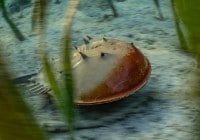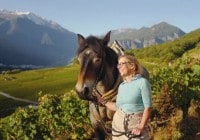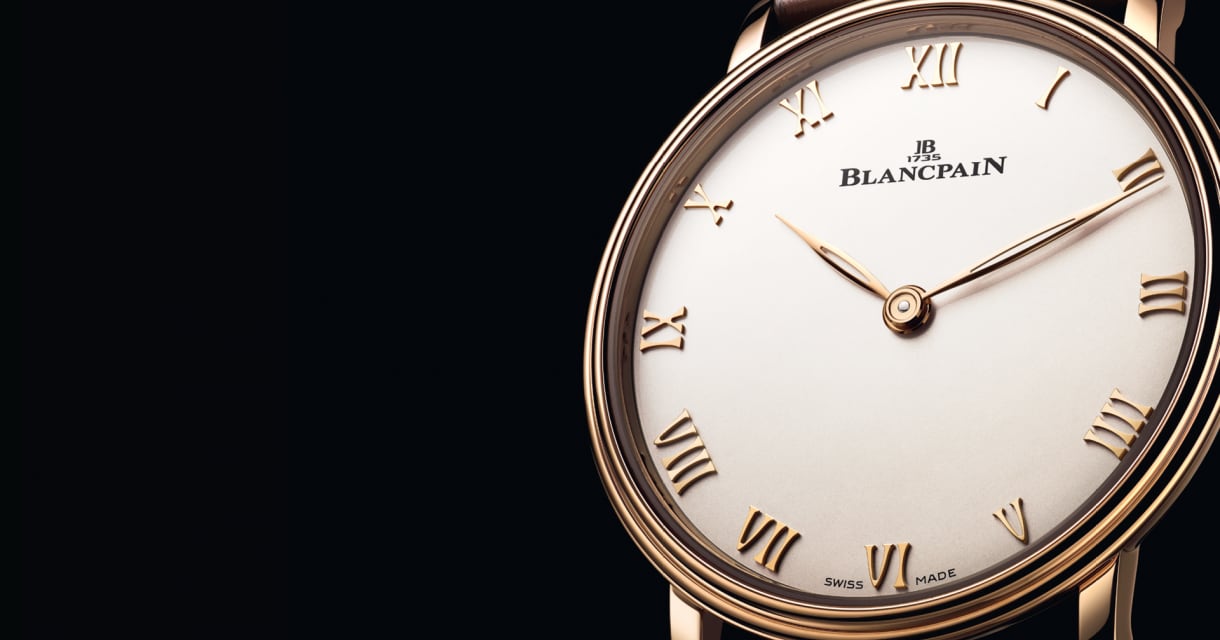
Search in Issues
Chapters
List of parts
Chapter 6
Anne-Sophie Pic
Anne-Sophie Pic’s rise to the Michelin pinnacle of three stars demonstrated courage and fortitude in abundance.

The late Julia Child, a much-beloved international cooking icon over her decades-long career, often spoke of the imperative of courage in the kitchen. Much of what she did occurred on camera in the age of “live” television and when things occasionally would go wrong, a not infrequent occurrence in front of a live camera, she often rebuked herself, in good humor, for not having had the courage of her convictions. Confirming Julia Child’s wisdom on courage being an essential for great achievements in cooking, the story behind Anne-Sophie Pic’s rise to the pinnacle of French cuisine demonstrates that quality in abundance.
Her flagship restaurant in Valence has been in her family for generations, three of which have been accorded Michelin’s ultimate accolade of three stars. Going beyond the approbation of Michelin, that summary, however impressive, omits the dramas of the ascents, descents, and passing of the restaurant from generation to generation.
The trail begins in 1889 when the restaurant Pic opened as a classic relais on the route from Paris to the South of France. Except for those days classified as rouge (signaling the ferocious traffic that clogs the roads at the start and end of the summer holiday period), travel to the South now can hardly be seen as a grand adventure. However, in the past, before the construction of today’s modern autoroutes, the trip along Les Routes Nationales was grueling, so much so that gastronomic stops on a multi-day journey became the norm. Who wouldn’t want to be fortified with Pic’s renowned gratin d’écrevisses before hitting the road again? With its strategic position south of Lyon in Valence on the Route du Soleil, Pic prospered and rose to become one of the most celebrated relais along the route, in the company of Fernand Point and Alexandre Dumaine. Its first rise to the coveted acclaim of three Michelin stars was achieved in 1934 by André Pic (son of the founders of the restaurant and grandfather of Anne-Sophie). Following the war, however, the strain of achieving perfection every single day took its toll, so that one star was lost in 1946 and a second in 1950. André’s son Jacques, who
initially did not see himself as a chef, a career as a mechanic initially catching his fancy, determined to restore the reputation of restaurant, winning back the second star in 1959 and again the prized third star in 1973.
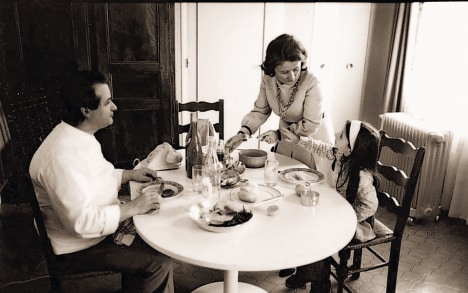
Anne-Sophie en famille with her father and mother.
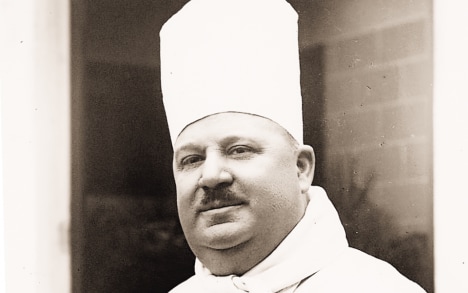
André Pic.
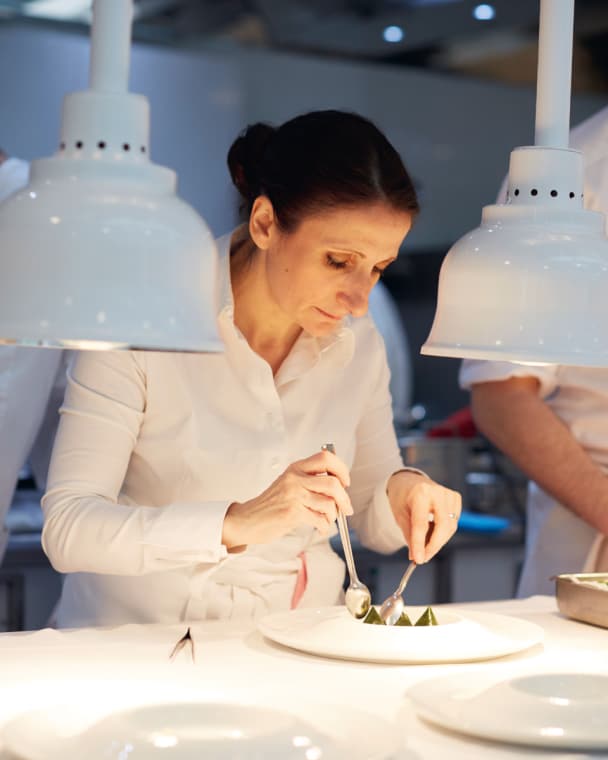
The French have a word to describe the passing of control of a restaurant from one chef to another: TRANSMISSION. The transmission to Anne-Sophie was particularly challenging.
Anne-Sophie grew up in a rarified gastronomic world. Banned were treats like bonbons or commercial biscuits, anything that was industrially produced. Instead, she was treated to wonderfully prepared family meals including raids on the restaurant’s larder by her father Jacques featuring foie gras, truffles, caviar and other luxuries. That did not, however, propel her to think of the restaurant as a career. Quite the opposite. To her, then living in the family quarters where today’s patisserie is located, the restaurant life felt too oppressive and consuming. Business attracted her and she set off for the Institut Supérieur de Gestion (ISG) in Paris, followed by internships in Japan and the United States.
It was Anne-Sophie’s time away from Valence that allowed her to understand truly what she loved and what she wanted to do. She returned to enter the kitchen and cook alongside her father. Tragedy struck a short three months later, when Jacques suddenly passed away following a heart attack. It fell upon Anne-Sophie and her brother to take the reins. With her background in business, she elected to run the front of the house, her brother taking charge of the kitchen. After two years, the all-important third star was lost, leading Anne-Sophie to change roles and assume command of the kitchen, determined to win back the honor of three Michelin stars.
The French have a word to describe the passing of control of a restaurant from one chef to another: transmission. Normally transmission within a family is planned long in advance with careful training and apprenticeships all aimed at smoothing the changing of the guard. Even under those circumstances the switch is daunting, with stress levels further increased by both food critics and clients being poised to search for the slightest stumble or diminishment in quality. If transmission can be forbidding even with the best-planned grooming, consider for a moment what confronted Anne-Sophie. She had not spent time in other restaurants apprenticing and being tutored with grand chefs. Her time training in the kitchen alongside her father lasted but three months. Only supreme self-confidence and gritty determination could overcome the challenges facing her when she took charge. Julia Child’s admonition to be courageous in the kitchen seems pale and inadequate measured against the obstacles faced by Anne-Sophie.
Anne-Sophie’s quest to REGAIN three Michelin stars SPANNED A FULL DECADE.
Anne-Sophie did, however, understand quality cuisine. Growing up in her father’s restaurant schooled her well in recognizing the elements of a grand restaurant experience at the three-star level. Moreover, she had an experienced team already in place and she cites the support she received from them. As her father had built strong ties with other stars in the French culinary world, she also had a network to call upon for support. Chef Marc Haeberlin of the legendary Auberge de l’Ill speaks fondly of calls he had with Anne-Sophie, offering his advice in this early period.
Her quest to regain the honor of the restaurant spanned a decade, when, finally in 2007, the third Michelin star returned to Valence, where it remains today.
This is not to say that these ten years were devoted to recreating her father’s cuisine in its entirety. As Jacques had evolved the restaurant from his father André’s repertoire, moving from tableside preparation of many dishes and large portions to a more modern menu of many dishes in modest portions, plated in the kitchen, she adapted to her time. Although several of Jacques Pic’s classics rotate through the menu such as his sublime bar de ligne au caviar and even a preparation recalling André Pic’s era, gratin d’écrevisses, she has revolutionized the conception of much of the menu. Her father and grandfather hewed closely to classic French cooking’s devotion to butter and cream sauces. Of course, sauces are the glory of French cuisine, but Anne-Sophie has reflected on ways to achieve an equivalent intensity of flavor without the heaviness of butter and cream. She considers that her approach is feminine, but applying that label would perhaps leave male chefs who have lightened their cuisine without an adjective. Whether or not the label should be “feminine”—an alternative might be “contemporary”—her quest was lightness with no loss of flavor.
Part of her answer came from her time in Japan. An omnipresent staple of Japanese cuisine is dashi, a savory sauce that is based upon kombu (fermented seaweed) and dried bonita tuna. In common with avant-garde cooks in Japan, she infuses a classic dashi with other flavor components. Indeed, her style moves beyond the approach of modern Japanese cuisine which, although introducing other flavor profiles to dashi, leaves the classic dashi dominant. Anne-Sophie uses the dashi as a background contributing savory notes, so that it is the other ingredients which take center stage. A perfect example is one of her signature creations Le homard bleu rôti au feu de bois, dashi aux fruits rouges, légèrement fumé, chutney de fraises à l’épine-vinette, betterave plurielle. The roasted lobster, subtly smoked from the wood fire, is paired with the sweet savory strawberry and raspberry dashi. There is a symphony of flavor, the sweetness of the lobster enhanced by the sweet red fruit broth, balanced with acid and the subtle umami of the dashi, all deepened further with the light touch of smoke.
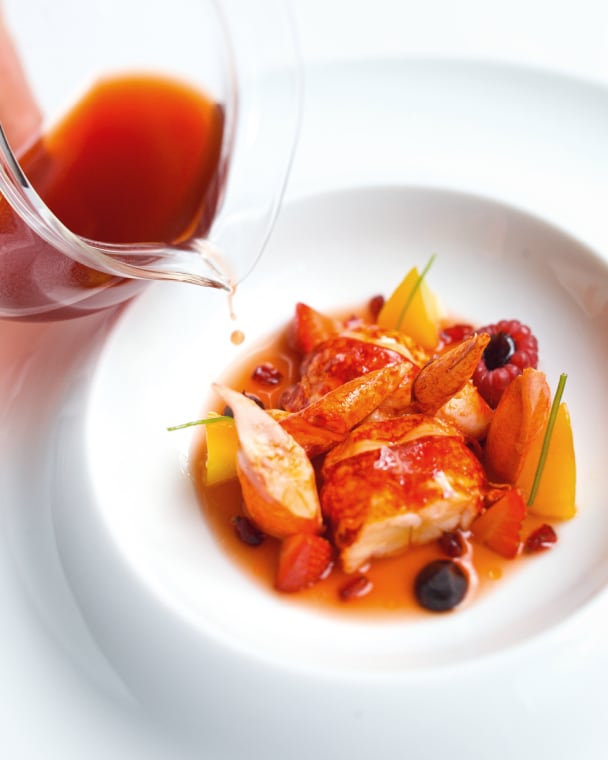
Le homard bleu rôti au feu de bois, dashi aux fruits rouges.
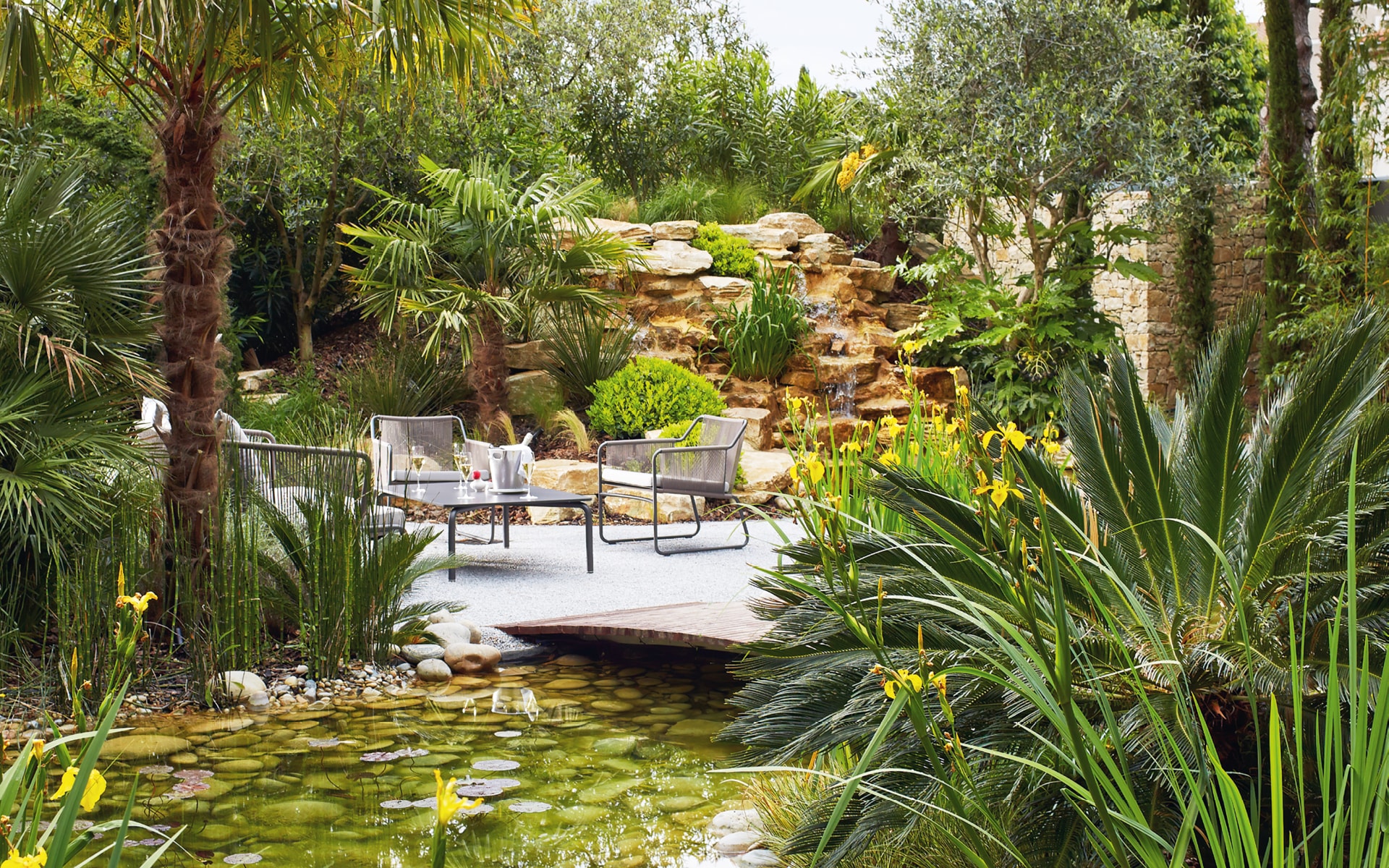
She and her husband, David Sinapian, who manages the commercial side excluding the kitchen, have now expanded the reach of her cuisine. Valence remains in place, of course. In addition, she has opened doors in Lausanne, Paris, London, and Singapore.
Although the location in Valence remains the same, there is no longer the hint that the family built it from an assembly of what formerly were antique shops. Working with her husband, they have completely transformed the ambiance of the relais with a sleek dining room overlooking the garden with large floor-to-ceiling windows, which in fine Japanese tradition visually pull the garden into the room. That Japanese style carries over to a large silk painting of cherry blossoms on the opposite wall. France reigns with the stemware, dramatic tulip-shaped Baccarat crystal glasses at each place setting.
When weather permits, starting the meal in the garden is a delight. Ferns, bamboo, small ponds, a waterfall, and bridges all flank intimate oases for enjoyment of an aperitif while pondering the menu and wine card. This is not to say that concentration on the menu and wines won’t be broken. An armada of amuse-bouches commands attention. Particularly riveting was what appeared to be a miniature lime. To be tasted in a single bite, it explodes in the mouth, releasing cascades of yuzu, anise and café.
In the era of her grandfather, meals were enlivened with tableside theater as many plates were finished on a cart in the dining room. A more contemporary theater began a recent visit with Le tourteau de casier, assaisonné à l’huile de sobacha torréfié, petites fleurs du jardin, crème glacée à l’estragon et au géranium rosat. There was much more to the dish than the delicately sweet crab with its tarragon sorbet, for it was accompanied by a cocktail, dramatically mixed tableside, featuring tarragon, chartreuse, sake, a citrus syrup, and seedlip (a confection of peas and rosemary). James Bond style, the cocktail was shaken, not stirred. Cocktail and crab are meant to be tasted together, as each complements the other.
La tomate plurielle, a composition of intensely ripe sweet multi-colored cherry tomatoes with a sage, saffron and mint broth shows not only her devotion to lightness, but also her talents in focusing upon a single ingredient. The peeled tomatoes explode in the mouth with an interior mixing olive oil and mint, the light broth offering an intriguing counterpoint.

La tomate plurielle.
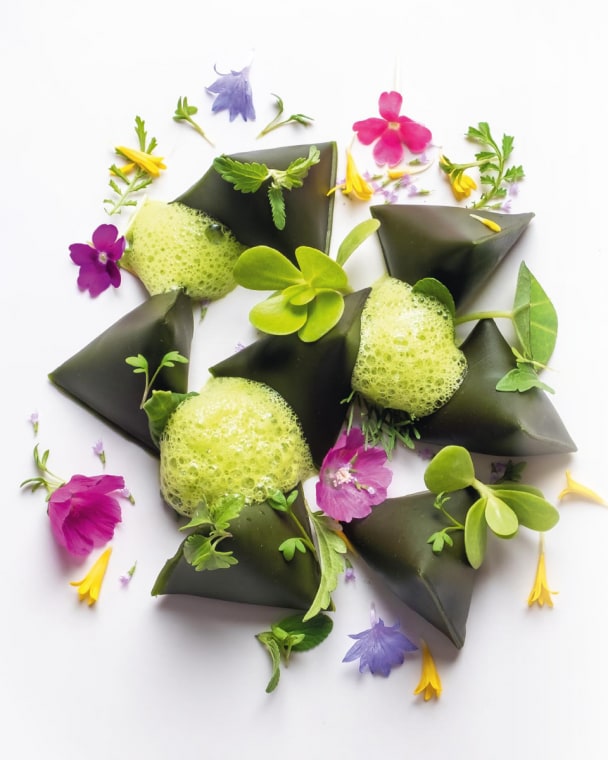
Les berlingots au chèvre.
Anne-Sophie’s preparations reveal exceptional DEVOTION TO DETAIL.
A signature preparation is Anne-Sophie’s berlingots. An Italian might describe these as pyramid-shaped ravioli. Depending on the location, the composition of the dish varies dramatically. In Valence, the pasta is green and adds Comté cheese and parsley to the traditional flour and egg dough. The filling is Banon goat cheese, watercress and a hint of ginger. The three pyramids were surrounded by a foamy watercress vegetable stock sauce infused with green matcha tea. Unlike many chefs in France who have a tendency to overcook the pasta, this would have been pleasing to the most discerning Italian palate as it was perfectly al dente. Interestingly, in Lausanne, the berlingots, although carrying the same pyramid shape, were dramatically different. Fitting to its region, the white pasta enveloped a riff on fondue with its Vacherin Fribourgeois / Gruyère / white wine filling laced with Kirsch (classic Swiss moitié-moitié fondue composition). Surrounding the berlingots were roasted ceps. Of course, there had to be a trick to enclosing fondue in pasta. Was the fondue solid before being encased? If so, melting the filling would overcook the pasta. Was it fully liquid? If so, how would it remain inside the pasta? The answer was clever. Cooking the filling and letting it cool so that it would be melted but not too liquid. A remarkable and clever achievement.
Anne-Sophie’s devotion to detail shows brilliantly in her La langoustine marinée au miel de trèfles, sauge, fleurs de fenouil, verveine et criste marine, haricots fins verts et beurre. Not only is she highly selective in favoring cold water langoustine from Scotland, for maximum flavor and texture, but she also insists that they be shipped alive to Valence and for several days are allowed to recover from the stress of shipping in a specially maintained tank. There is an intriguing synthesis of flavors with the sweet briny langoustine playing off its clover honey basting, sage, fennel flower, and verbena. The sauce base is a classic shellfish stock deepened with a subtle hint of dashi.
Le bar de ligne au caviar osciètre is an important dish in the family’s history. Created by her father in 1971, it was one of the foundations to his earning the third star two years thereafter. The line-caught bass is steamed until just translucent and generously topped with caviar from Aquitaine. In keeping with the luxury of the caviar, the butter sauce base is Salon champagne. This preparation is a glorious tribute to classic French cooking with both its delicacy and depth of flavor.
Exceptional CREATIVITY is on display in the DESSERTS.
Exotic spices play an important role in Pic’s repertoire. This was much in evidence in Le bœuf du Val d’Hérens, mariné à la baie des Minorités, tequila et tagette, jeunes poireaux et courgette. Here traditionally seared and roasted beef was first marinated in tagette, a Mexican variety of tarragon and, in keeping with that regional theme, tequila. By no means was this Mexican fusion cuisine, as the two components of the marinade served to bring an intriguing twist and punctuation to the richness of the beef.
Desserts vividly display her creativity even when they bear the familiar description mille-feuille. Traditionally a mille-feuille would offer two or three layers of filling separated by and topped with butter-based puff pastry. At Pic, Le mille-feuille blanc, crème légère à la vanille de Tahiti, fine gelée au jasmin, émulsion au poivre Voatsiperifery hews to tradition with its layered construction, but in every other respect is entirely novel. Anne-Sophie reimagined the mille-feuille as a pure white cube. Its monochromatic exterior conceals a yogurt cream, jasmine jelly, and milk mousse infused with pepper. Keeping butter puff pastry to a minimum, the cube construction substitutes thin layers of meringue accented with lemon.
While the mille-feuille started with a classic concept and thoroughly modernized it, her Chocolat créé par Valrhona pour Anne-Sophie Pic comme un nid d’abeille, panna cotta au miel amer de Corse, crémeux et ganache au thé Hojicha Cubèbe is entirely original. Although Valrhona chocolat is known and revered worldwide, it is a local product finished in Tournon, less than 20 km distant from Valence. It has been formed into a flat honeycomb on the plate, with its recesses alternately filled with arbutus flower honey panna cotta, dark chocolate, chocolate ganache, and caramel infused with tea.
Anne-Sophie’s achievement in propelling her restaurant back to the very top of the French culinary world without the benefit of years of training and apprenticeships is singularly remarkable, made even more so considering that she became a mother during the same period. Of course, what matters to her diners is less how she persevered and overcame her obstacles, but the remarkable creativity and attention to detail on display with every dish.
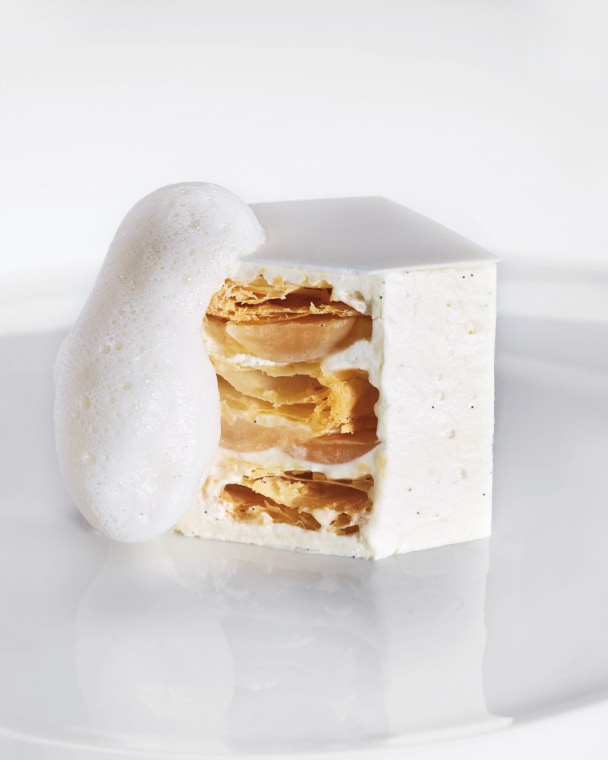
Le mille-feuille blanc, crème légère à la vanille de Tahiti, fine gelée au jasmin, émulsion au poivre Voatsiperifery.
Other issues
Don't miss the latest issue
Sign Up for New Releases



